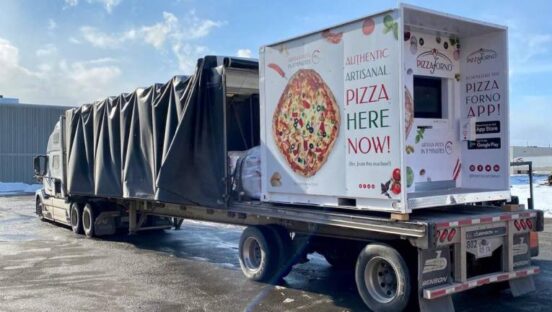Amid an economic atmosphere experiencing soaring rent, labor, and food costs, technology is continuing to provide a lifeline for restaurant operators. One innovation has been pressing at the forefront of the pizza industry and is ready for the limelight—automation.
Brands such as PizzaForno and Pizza Jukebox are foregoing traditional methods of prepping and allowing robots to don a chef’s hat to fulfill growing consumer needs.
PizzaForno’s journey started in a small town north of Paris, where co-founder and president Les Tomlin spotted an 85-year-old woman getting a pizza out of a wall.
“We thought if we could get this technology to North America with a brand attached to it, we could resolve a whole bunch of risks,” Tomlin says. “Issues like labor, real estate costs, waste, and availability 24/7 could all be solved.”
Together with his partner Will Moyer and members of French businessperson Vincent Le Gouic’s culinary team, Tomlin secured North American rights to the technology and embarked on eight months of research, development, and branding.
The result? A kiosk complete with a 32-inch touchscreen, robotic arm, and a convection oven that bakes artisanal pizza in about three minutes. Currently, customers have eight types of pizza options, from classic pepperoni to flavors like honey and goat cheese.
The process begins with Sysco, which delivers ingredients and utensils to each unit, which can hold up to 70 pizzas. Then, once a customer places an order, the robotic arm retrieves a pizza from the refrigerated section and places it into the oven. If a customer prefers to bake their pizza at home, they can do so. The pizzas take about six minutes to bake in a conventional oven.
The first 50 PizzaForno locations began operating throughout Canada and eventually sprawled across the U.S. border to states like Michigan, Louisiana, and Georgia. With the U.S. division spearheaded by quick-service veteran Travis Edmondson, the company is propelling ahead with the goal of 20,000 automated kiosk locations by 2026.
Key markets of growth include Northern and Southern California, rural Texas, Miami, and more. Interestingly, Tomlin notes, “Originally, it was a bunch of entrepreneurs who gave us a shot, and those were our first licensees. Now, we are getting much more seasoned [quick-service] operators, such as multi-unit operators from Sonic franchises, who really understand the power of this model.”
Additionally, PizzaForno’s expansion strategy is diverse: Tomlin points to both small-town rural segments and bustling college campuses.
“We can provide a hot food option in markets that are too small for the big players to operate in,” Tomlin explains. “We’re in a town called Bolivar, Texas, and it is one of our top-performing units right now because there’s literally no food within 15 miles of that location.”
On college campuses, PizzaForno provides a 24-hour solution to students’ late-night hunger. The brand works closely with local brand ambassadors, such as campus Greek life and sports teams. Tomlin explains that over 35 percent of university business is done between midnight and 3 a.m.
Moreover, customers have the option of pre-ordering pizza for pickup. For example, parents can purchase a meal through the PizzaForno app and send their starving college student a code to go pick it up at the nearest kiosk.
In the future, Tomlin is looking forward to exploring more markets such as amusement parks, partnering with third-party services, and growing PizzaForno’s presence through small towns, university campuses, and corporate chains.
Like PizzaForno, Pizza Jukebox—which opened in June inside a Walmart in Frisco, Texas—is fully automated. However, the process is more experiential. The idea is that once an order is placed, customers will watch in awe as a robotic arm lifts the pizza onto a platform where it is dressed with sauce, cheese, and toppings, all while spinning to ensure consistency. Then, the pizza is placed into an oven where it is baked for about three minutes.
Here is where it gets intriguing: customers will also be able to choose a song to listen to while the pizza is spinning, like a vinyl on a record player. That’s how the name “Pizza Jukebox” came to life.
When BRIX Holdings CEO Sherif Mityas sought to add a pizza concept to his portfolio, he wanted something unique. He wanted something to capture customers’ attention and create a compelling experience.
“I’m a big fan of utilizing technology to create and support great experiences,” Mityas says. “We wanted to marry something very innovative with great tasting pizza that’s got a little bit of theater attached to it.”
Pizza Jukebox will add to BRIX Holdings’ portfolio of brands, including Red Mango, Smoothie Factory, Souper Salad, RedBrick Pizza, and Greenz. The Dallas-based company plans to integrate Pizza Jukebox into existing Red Mango locations.
“We are trying to balance something ‘guilty pleasure’ with something healthy,” Mityas explains. “The Red Mango menu allows us to provide the beverage and treat that would go along with pizza and gives guests the opportunity to enjoy both of our brands in one setting and occasion, separate but connected.”
Initial markets for Pizza Jukebox will be in suburbs surrounding Dallas, but Mityas is confident the concept has potential to expand quickly. He points to a future partnership with Walmart as well as other standalone opportunities.
“Built-in traffic will be a great way to provide their associates and guests with food,” Mityas says. “The opportunity to expand is there, not just with Walmart. We believe this has the potential to have 100-200 units in the next three years.”
To alleviate pressure, restaurants have had to get creative, and these concepts are no exception. Tomlin says North America is simply catching up to the rest of the world in terms of automated machine technology.
“Once people try it, they will say ‘Wow, I cannot believe this quality of pizza is coming out of an automated pizzeria,’” Tomlin says.









